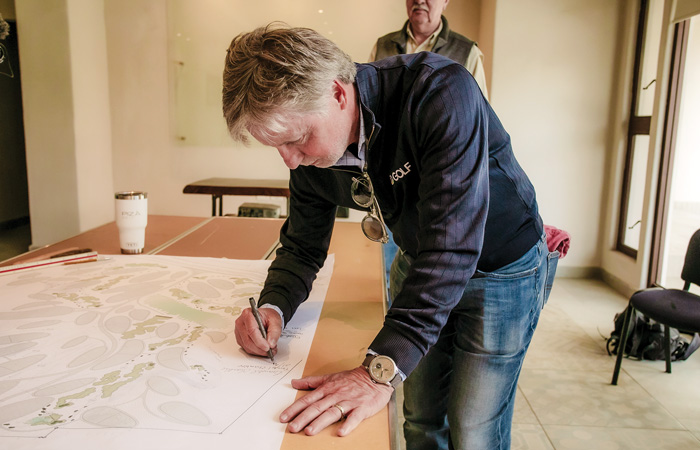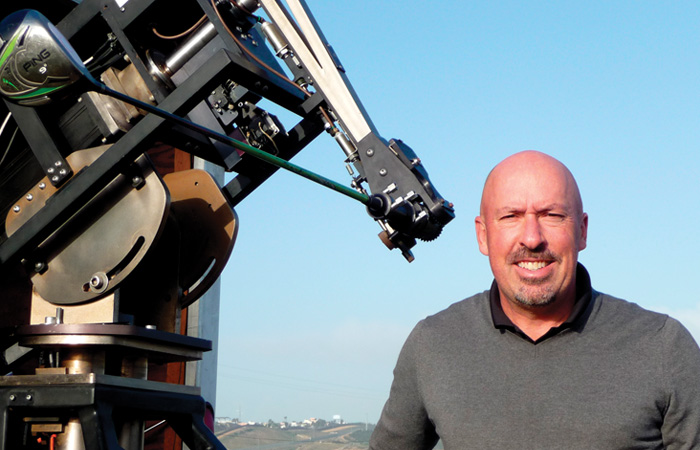Famous British poet of the 1600s, John Milton, wrote “On His Blindness” in which he said, “They also serve who only stand and wait.” Surely this applies nowhere else so much as to the caddies who serve their players quietly, efficiently and patiently for days, weeks, months and years on end.
The 21st century PGA TOUR caddie is a far cry from the pot-bellied, beer-chugging, hot-dog eating person of the past. They’re younger, fitter, and typically former players who, at one time, had their own ambitions to compete, and thus have an insider view of the game at the highest level.
During the PGA TOUR’s 2025 Farmers’ Insurance event hosted at Torrey Pines in San Diego, several caddies were amused and pleasantly surprised to be asked whether they would be willing to be interviewed for an article, rather than their famous golf bosses. Geno Bonnalie is one of the most experienced caddies of those interviewed, as he has been with Joel Dahmen for almost 11 years. Naturally, the first question for him was, “What’s with all the ups and downs – are the issues physical, mental, or perhaps something to do with injury?” Bonnalie responded, “It’s just golf. Golf is a very hard sport to play consistently. I think it’s very cyclical … always up and down. When you’re playing good, it’s great, when you’re playing bad, it feels like you’re never gonna play good again.”

Bonnalie and Dahmen grew up together and have been friends for a long time. Did he ever have any ambitions to be a pro himself? “Yeah,” Bonnalie said, “but I just wasn’t good enough.” How do so many caddies know this, one wondered? In his case, it was that “Joel always beat me very badly even as kids, so I knew that he had it and I did not, even though I was an OK player.”
Given their long-time relationship, what does he do for Dahmen? Most especially, he helps him have a “Positive mental attitude. He trusts me. I feel like I make smart decisions,” Bonnalie said. “Obviously, there’s times where I make mistakes and make a wrong decision, but I think my golf IQ is pretty high. And we have a great relationship to where I can be truthful and tell him what I think. Sometimes I’m wrong and I get in trouble, but I always have a reason for what I do.”
Mainly he believes that strategizing around the golf course – when it’s time to take a risk versus be smart – realizing that pars and sometimes even bogeys are a great score. Trying to minimize doubles is what’s important.
Does Bonnalie have any aches and pains from lugging around a golf bag he estimates to weigh 45 lbs. for over a decade? He does have feet and some back issues, but right now feels healthy, and stretches sometimes. And for his hard work, a caddie such as him can expect a base weekly salary plus anywhere from five to 10 percent of his player’s earnings, depending on the relationship with the player.
David Flynn is Trey Mullinax’s caddie. If he is even half as efficient a caddie as he is at responding to questions for this interview via text, he must be a great support system for his player. This 32-year-old has been caddying professionally since he was 22, but also grew up caddying at country clubs since he was 15. As with most modern caddies, he got into caddying because, “I played in college and was no way near good enough to play professionally,” Flynn said. “A friend and teammate asked me to caddie for him a little bit, and I liked the job and … well, 10 years later, I’m still doing it.”

Flynn and Mullinax worked together for almost five years from 2016-2020, then spent a few years apart, and reunited last year. He’s also worked for Kevin Tway and Robby Shelton, as well as a few others.
What does he do for his players? “Every job is different out here … and to be perfectly honest, even day-to-day, week-to-week, the job can change with a player,” Flynn said. “There’s certainly a factor of helping with strategy on the course. But ultimately, I think this job is about being good company, as a player has to be around his caddie a lot and in a lot of different circumstances. Some more intense than others. A good caddie is someone a player wants to be around, trusts in a pressure situation, and can rely on for anything from showing up on time to telling the hard truth.”
Sadly, Flynn does have a few aches and pains to show for his many years of caddying for professional golfers. “This is the only body I’ve got and I’m afraid I haven’t treated it kindly by lugging around that darn bag for 10 years!” he said.
Another caddie who lugs around a famous bag is Will Wilcox, who caddies for Sungjae Im. Will actually played the Korn Ferry and PGA Tours for four years. He’s 38-years-old now and does have some aches and pains but says “It’s not too bad.” In fact, perhaps it is to be expected given that he caddied for Im for 27 of 52 weeks last year, carrying around a 30 lb. bag, which is “Not too heavy, but is a little awkward,” he said.
The remuneration for the job probably made it all worthwhile, with a base weekly salary of $2000 and seven percent of his player’s earnings – given that Im made $10 million in 2024. Wilcox helps his player a lot and is able to offer advice on, “Picking the number, determining how long it’s going to be playing, what club to use, how the lie is going to impact the shots, and I also read most of the putts.”
The person who caddies for in-form Justin Lower is Chad Gonzales. “This is my third year with him,” says Gonzales. He did try to play competitively himself early in his career, but it was a financial struggle and it “Just wasn’t working out.” What he does do best for his player is to “Keep my player calm, comfortable and confident,” as well as help in the prep work along with the coach, by ‘walking the course’ and knowing everything his player might require of him.
He also looks at a lot of PGA TOUR data – from the last few events as well as from previous years. This helps him offer suggestions on the best way to play the course. For instance, where did most of the field make birdie where his player did not? He also looks at “feet of putts made” (the sum of all actually holed putts on every green totaled over all 18 holes). For Lower, a good number is about 80 to 85. Gonzales is an enthusiastic 36-year-old caddie who works with his player’s trainer once or twice a week to stay fit and avoid any pain.
Another golfer whose game is improving in recent months is Rico Hoey. His caddie, 38-year-old Brian Martin, has been with him for two years, prior to which he caddied for Kurt Kitayama. “I used to play and then I had to figure out a way to make some money.” Martin said. He found it easy to caddie for pros because of his playing background, as players prefer caddies who have played with them in the past and can rely on what they’re saying more. Martin has been “on the road” since he finished school and mainly helps his players have a positive mindset. When someone is hitting the shots, they might see something negative like a water hazard, while he only sees good shots and where the golfer should go.
“Everyone gets mad and upset or angry or whatever it is – you just gotta try to pull them back to know that they’re good enough to start a good stretch,” he said. Martin goes to the gym “all the time,” even though his golf bag currently weighs only 25 lbs, compared, as he says, to the typical 40 lb. ones.
A more recent addition to caddie ranks is 28-year-old Dan Woodbury, who has been caddying for Trevor Cone for three years. “Trevor and I were college teammates – we played golf together at Virginia Tech (where Woodbury earned a finance degree). We were college teammates and just good buddies, and he asked me to start caddying for him,” Woodbury said.

Did Woodbury ever have playing ambitions of his own? “I did, so I was doing that before he asked me, and I was ready to give it up and look into the finance world and do something else … and just got lucky with the timing of it,” he said. Which helped him to remain in the golf world, something he loves, especially as he’s in good shape and his average-for-Tour 40 lb. bag does not seem to be a bother for him.
What he uniquely brings to the table for Cone is a mixed bag. A lot of it for him happens from Monday through Wednesday before a tournament starts. Observing how Cone practices and getting ready for the tournament each week. Then, course management-wise what to hit off tee boxes, targets, reading greens – he says he wears a lot of different hats. His best skills are green reading and building a practice schedule. “For each of us, we all do different jobs – depending on what our players want,” Woodbury said.
Raphael Campos has a relatively young 23-year-old caddie, Cameron Smith. “I grew up playing golf. I played in college, and I really wanted to go down the golf route,” Smith said. “I was playing a lot and I felt like I got as good as I could, and I couldn’t beat the best guys around me. It’s a very fine line in golf between being good and great. I’m still an amateur, so I can play tournaments whenever I want to.”
Smith has already been caddying for four to five years. This young caddie does not find the 40 lb. bag he carries around to be a big deal and said, “It’s not too bad – you kind of get used to how much it weighs.”
The caddie of the 21st century is a younger, fitter, more enthusiastic version of those of bygone years and probably quite eager to partake of a piece of the ever-increasing pie that is the PGA TOUR purse. Even the 18-hole walk over ever-lengthening, hilly courses and the unnecessarily heavy, balance-diminishing golf bags do not seem to deter these brave men or be a cause for complaint. No one seemed to be dissatisfied with the job and, in fact, said that “Caddying is a great way to stay in the game competing” or “It’s fun” or “I wanna keep doing this for the rest of my life.”
Thus, the PGA TOUR is not only profitable for the players themselves and the many charities it serves, but also for another group of happy campers – the caddies.